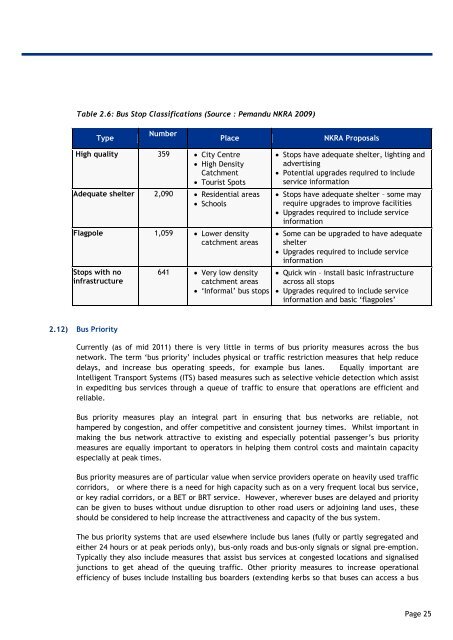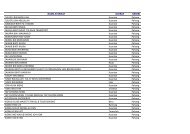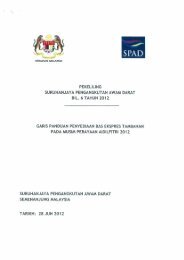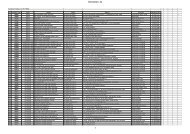Contents - SPAD
Contents - SPAD
Contents - SPAD
Create successful ePaper yourself
Turn your PDF publications into a flip-book with our unique Google optimized e-Paper software.
Table 2.6: Bus Stop Classifications (Source : Pemandu NKRA 2009)<br />
Type<br />
Number<br />
Place<br />
NKRA Proposals<br />
High quality 359 City Centre<br />
High Density<br />
Catchment<br />
Tourist Spots<br />
Adequate shelter 2,090 Residential areas<br />
Schools<br />
Flagpole 1,059 Lower density<br />
catchment areas<br />
Stops with no<br />
infrastructure<br />
641 Very low density<br />
catchment areas<br />
„Informal‟ bus stops<br />
Stops have adequate shelter, lighting and<br />
advertising<br />
Potential upgrades required to include<br />
service information<br />
Stops have adequate shelter – some may<br />
require upgrades to improve facilities<br />
Upgrades required to include service<br />
information<br />
Some can be upgraded to have adequate<br />
shelter<br />
Upgrades required to include service<br />
information<br />
Quick win – install basic infrastructure<br />
across all stops<br />
Upgrades required to include service<br />
information and basic „flagpoles‟<br />
2.12) Bus Priority<br />
Currently (as of mid 2011) there is very little in terms of bus priority measures across the bus<br />
network. The term „bus priority‟ includes physical or traffic restriction measures that help reduce<br />
delays, and increase bus operating speeds, for example bus lanes. Equally important are<br />
Intelligent Transport Systems (ITS) based measures such as selective vehicle detection which assist<br />
in expediting bus services through a queue of traffic to ensure that operations are efficient and<br />
reliable.<br />
Bus priority measures play an integral part in ensuring that bus networks are reliable, not<br />
hampered by congestion, and offer competitive and consistent journey times. Whilst important in<br />
making the bus network attractive to existing and especially potential passenger‟s bus priority<br />
measures are equally important to operators in helping them control costs and maintain capacity<br />
especially at peak times.<br />
Bus priority measures are of particular value when service providers operate on heavily used traffic<br />
corridors, or where there is a need for high capacity such as on a very frequent local bus service,<br />
or key radial corridors, or a BET or BRT service. However, wherever buses are delayed and priority<br />
can be given to buses without undue disruption to other road users or adjoining land uses, these<br />
should be considered to help increase the attractiveness and capacity of the bus system.<br />
The bus priority systems that are used elsewhere include bus lanes (fully or partly segregated and<br />
either 24 hours or at peak periods only), bus-only roads and bus-only signals or signal pre-emption.<br />
Typically they also include measures that assist bus services at congested locations and signalised<br />
junctions to get ahead of the queuing traffic. Other priority measures to increase operational<br />
efficiency of buses include installing bus boarders (extending kerbs so that buses can access a bus<br />
Page 25

















